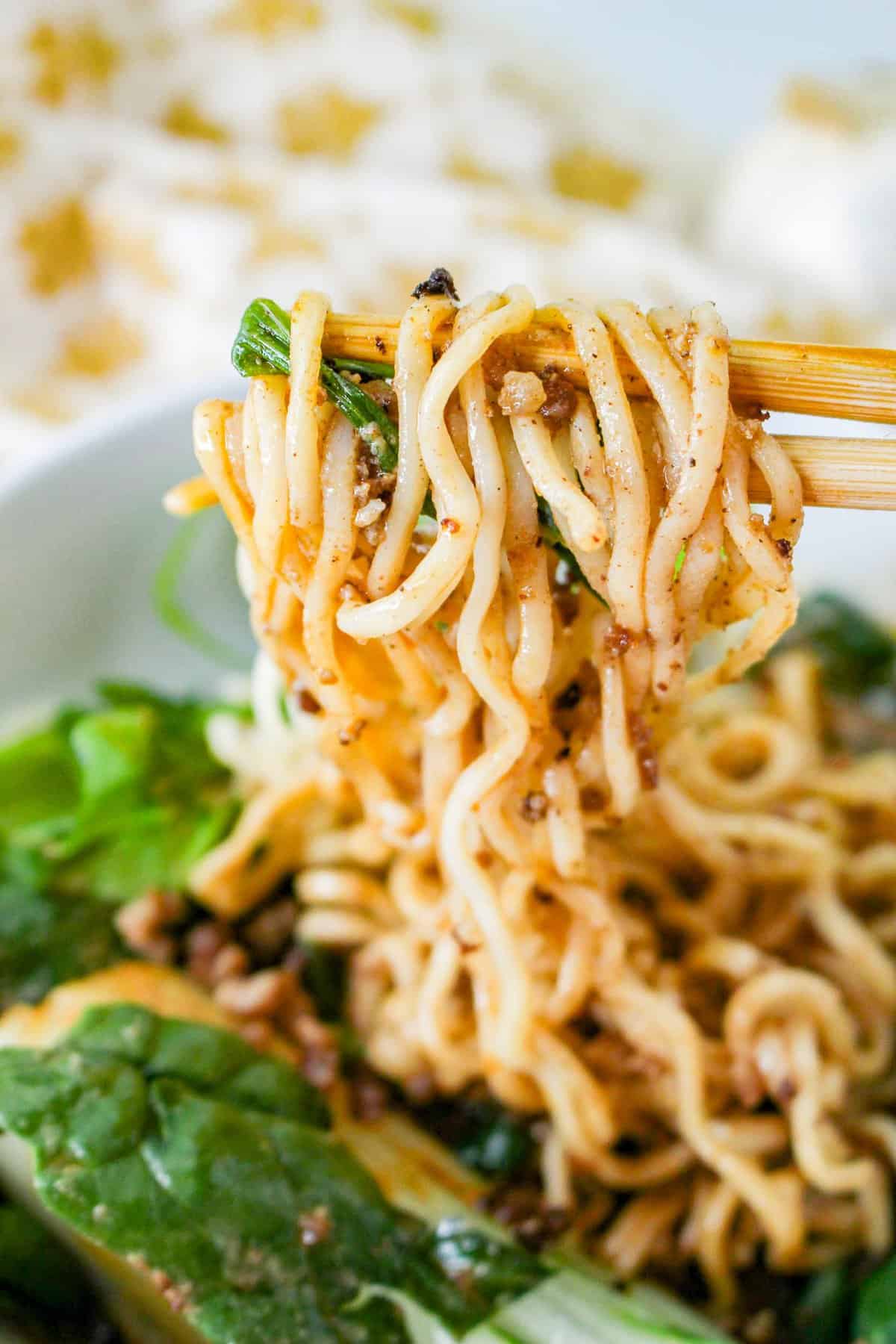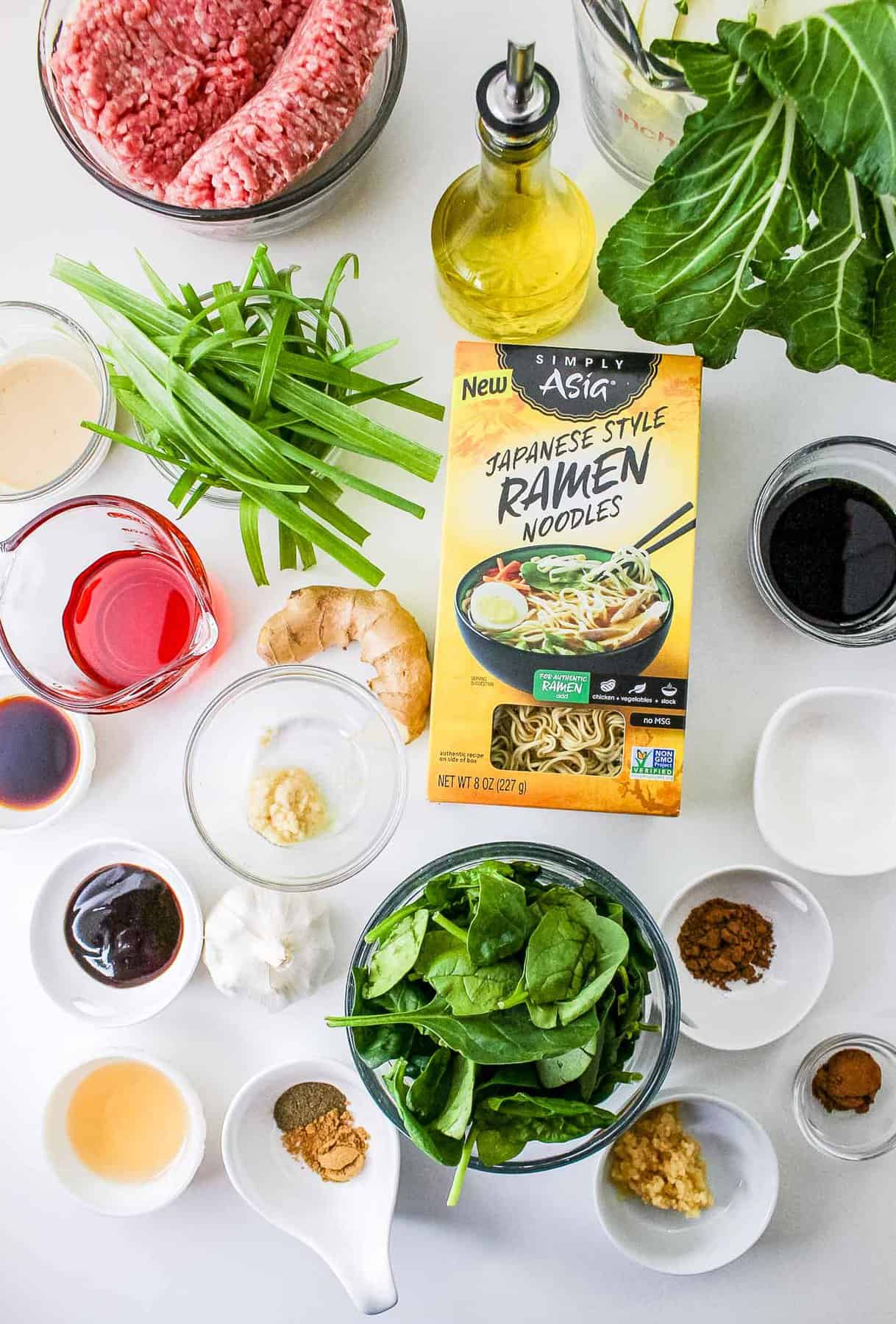Dan Dan Noodles are an irresistible tangle of flavors and textures — slippery, toothsome noodles; fiery spice, meaty ground pork; crisp-tender veg; mouth-tingling Sichuan pepper; a riot of aromatics and spices; and deep, nutty umami. This famously mouth-numbing Chinese noodle dish is utterly irresistible for spicy food lovers.

This post may contain affiliate links. As an Amazon Associate, I earn from qualifying purchases. See my Affiliate Disclosure.
If you’re not already familiar with Sichuan cuisine, authentic dan dan noodles are a great introduction. The recipe includes many of the trademark flavors of the cooking style, including Szechuan peppercorns and five-spice powder. Dan Dan Noodles aren’t for the faint of heart—the flavors are big and bold, perfect for anyone who loves spicy Asian noodles.
I use thin, wheat-based Chinese noodles, which are similar to ramen or yakisoba noodles. They’re great for soaking up the flavors of the rich sauce and ensnaring the savory bits of meat, usually ground pork, and leafy greens like spinach or bok choy.
But the real star of the show, and what sets Dan Dan Noodles apart, is the sauce. It’s a fiery blend of Chinese sesame paste, chili oil, fresh garlic, and ginger. This sauce is both spicy and nutty, with a hint of sweetness to balance out the heat. It’s also incredibly aromatic, making the dish as much a treat for the nose as it is for the palate.
Finally, the dish is finished with fresh, crunchy greens like bok choy or spinach and a sprinkle of green onions, which add a pop of color and a burst of freshness to balance the rich, spicy sauce.
All these elements together create a dish that’s a symphony of flavors: spicy, savory, a little sweet, and utterly umami. The textures, too, are part of the appeal, with the soft noodles, the crunchy greens, and the meaty ground pork each playing their part. It’s this combination of taste and texture that makes Dan Dan Noodles such a treat.

What are Sichuan dan dan noodles and why the name?
Dan Dan Noodles, or Dan Dan Mian as they’re known in China, are a classic dish originating from the Sichuan province. The name “Dan Dan” refers to the pole that street vendors would carry over their shoulders, with noodle pots hanging from each end.
The recipe for these spicy Sichuan noodles gained popularity because the dish was affordable, portable, and, of course, offered savory and addictive flavor.

Ingredients you need
This dish wouldn’t be what it is without a unique blend of ingredients. Here’s what you’ll need to bring a bowl of Dan Dan Noodles to life:
- Noodles: The best noodles to use are Chinese wheat noodles, ramen noodles (not the instant kind), or yakisoba noodles. You can also use thicker, chewier udon noodles. You can use fresh noodles or dried noodles. You can even substitute rice noodles to make a gluten-free version (just make sure you use gluten-free versions of the other ingredients, like soy sauce and hoisin sauce, too.)
- Cooking oil: The backbone of any stir-fry dish. You can use any cooking oil with a neutral flavor and high smoke point. I like safflower oil, but you can also use sunflower oil, canola oil, corn oil, vegetable oil, grapeseed oil, or avocado oil.
- Ground Pork: This gives the dish its meaty depth. If you’re vegetarian, you can substitute crumbled tofu — try my Vegetarian Dan Dan Noodles recipe.
- Hoisin Sauce: This adds a sweet and tangy flavor. Oyster sauce can be used as a substitute.
- Shaoxing Wine: A traditional Chinese cooking wine. Dry sherry makes a good substitute, or you can use mirin, sake, or any dry white wine.
- Soy Sauce: Gives the dish its umami and salty notes. Tamari or gluten-free soy sauce can be used for a gluten-free option (you’ll need to use something like rice noodles in place of wheat noodles).
- Five Spice Powder: This blend of common Chinese spices contains 5 warming spices: Star anise, cloves, cinnamon, Sichuan peppercorns, and fennel seeds. It gives the sauce a hit of warm, sweet flavor.
- Sichuan peppercorns (AKA Szechuan pepper): This is the distinctive mouth-numbing spice that makes Dan Dan Noodles and other Sichuan dishes so intriguing.
- Bok choy and spinach: Add a touch of green and a nice crunch. You can substitute with any greens you have on hand. Traditional recipes using include preserved vegetable, which you can certainly add if it is available.
- Green onions: Give a fresh, pungent kick.
- Chili oil: Brings the heat! You can use store-bought or homemade chili oil. Adjust the quantity according to your spice tolerance.
- Chinese sesame paste: It provides a rich, nutty flavor. Unlike Middle Eastern tahini, Chinese sesame paste is roasted to a deep golden toastiness. Japanese sesame paste is similar and can be substituted. If you can’t find either, you can substitute a combination of tahini and toasted sesame oil. If you don’t have any of those things, you can substitute all-natural, no-sugar-added peanut butter.
- Sugar: Just a touch to balance out the spice.
- Fresh Garlic and Fresh Ginger: Using fresh aromatics gives the dish a punch of fresh, zesty flavor.



How to make it
Cooking Dan Dan Noodles is all about layering flavors. Here’s how:
- First, you’ll cook the noodles according to package instructions, leaving them a bit al dente, adding the bok choy a minute or so before draining.
- Next, you’ll make the sauce, which is a mixture of hoisin sauce, Chinese sesame paste, chili oil, sugar, Shaoxing wine, and soy sauce, punctuated by fresh garlic, ginger, five-spice powder, and Sichuan peppercorns.
- While the noodles cook, stir fry the ground pork, browning it to perfection, ideally in a wok, but a large, heavy-bottomed skillet works well, too. Once the meat is browned, stir in the sauce and cook, stirring, until it is well mixed and the sauce is hot. Add the spinach and cook just 30 seconds more, until it starts to wilt.
- Finally, toss it all together — the cooked noodles and bok choy and the meat-and-sauce mixture. Garnish with sliced green onions and a drizzle of chili oil, if desired, and serve.

How to serve it
This Dan Dan Noodles recipe includes all the elements of a complete meal, but if you want to serve additional dishes, there are lots of options. You could start with an appetizer of steamed Har Gow shrimp dumplings or pan-seared Chicken Potstickers.
A Spicy Cucumber Salad adds freshness. If you want something more cooling to counter the fiery noodles, a Japanese Cucumber Salad or Kachumber Salad would be just the thing. Or go a different direction with Dry Fried Green Beans or Pan-Seared Brussels Sprouts with Soy Glaze.

Sichuan Dan Dan Noodles
Ingredients
- 1 teaspoon oil
- 1/2 pound ground pork
- 2 teaspoons Hoisin sauce
- 2 teaspoons Shaoxing wine
- 1 teaspoon soy sauce
- 1/2 teaspoon five-spice powder
- 1/4 teaspoon kosher salt
- 1 8-ounce package ramen noodles
- 2 cups spinach
- 4 stalks bok choy
- 4 green onions trimmed and sliced through the length
For the sauce:
- 1/3 cup chili oil
- 2 tablespoons chinese sesame paste
- 3 tablespoons soy sauce
- 2 teaspoons sugar
- 2 cloves garlic minced
- 1 teaspoon grated fresh ginger
- 1/2 teaspoon five spice powder
- ¼ teaspoon ground szechuan peppercorns
- 1/2 teaspoon freshly ground black pepper
- 1/2 teaspoon ground coriander
Instructions
- In a heavy skillet over medium-high heat, heat the oil. Add the ground pork and cook, breaking up the meat with a spatula, until the meat is well browned. Add the hoisin sauce, wine, soy sauce, five-spice powder, and salt. Stir to mix well and then remove from the heat.
- Meanwhile, bring a pot of water to a boil and cook the noodles according to the package directions. In the last minute of cooking, add the bok choy. When the cooking is complete, remove the bok choy. Save 1 cup of the cooking water. Drain the noodles and rinse under warm water.
- In a small bowl, make the sauce. Mix together the chili oil, sesame paste, soy sauce, sugar, garlic, ginger, five-spice powder, ground Szechuan peppercorns, black pepper, and ground coriander. If the sauce is too thick, add a bit of the reserved noodle cooking water.
- Divide the noodles among 4 bowls. Add one piece of bok choy to each bowl. Spoon the sauce over the noodles and top with the pork. Garnish with the green onions and serve.
Notes
You can substitute a combo of tahini and sesame oil for the Chinese sesame paste. Or substitute no-sugar-added peanut butter.



this recipes is missing the instructions
No, it isn’t.
Even with the handful of substitutions I made for the sauce, this recipe came out fantastic!